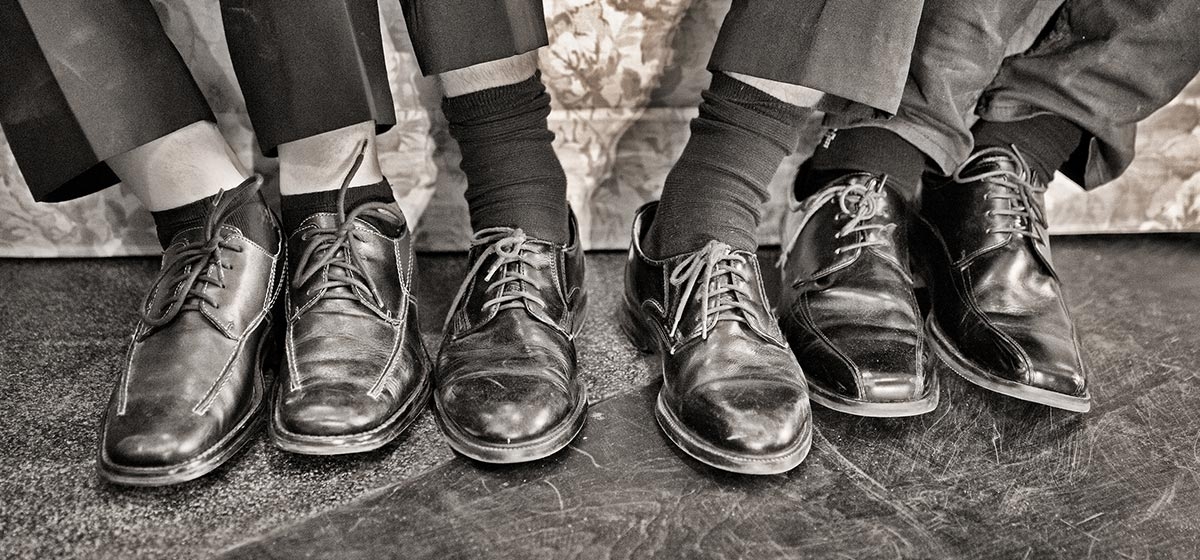Don’t Dress Like a Hillbilly

Last week we discussed one of the major hurdles recent immigrants from southeastern Kentucky faced when they tried to assimilate into middle class society in Ohio: they talked like hillbillies. This week we’ll look at a second hurdle: the matter of dress.
In “Hillbilly Elegy,” J. D. Vance notes that his Papaw wore the same outfit every day: painter’s pants and a graying tee shirt with a pocket for his smokes. Papaw also believed in “air drying” his clothes. By this he meant tossing his attire into the washing machine, running it through a full cycle, then leaving it in the machine to “air dry.”
When Papaw finally got around to taking his clothes out of the washing machine they were wrinkled and smelled of mildew. But he simply put them on and went about his business. It wasn’t that Papaw didn’t notice that respectable men in Middletown, Ohio didn’t dress like he did, it’s just that Papaw didn’t give a damn. Dressing like a bum was perfectly acceptable in Jackson, Kentucky, and if it wasn’t acceptable in Middletown, that was Middletown’s problem.
Papaw’s attitude may seem perverse to us—to say nothing of being antithetical to his own chances for success in Ohio—but that’s only because we don’t understand the power of the cultural legacy Papaw brought with him to Middletown.
To try to get at what motivated Papaw, let’s look at a situation that is more familiar to us. A woman we’ll call Amal has left her Middle Eastern country and migrated to Dayton, Ohio with her husband. Amal believes that a woman should always behave modestly in public and should cover herself whenever she leaves her home. So she wears a burqa. (Actually, Amal wears a niqab, but since no one in Dayton, Ohio knows what a niqab is, we’ll call it a burqa.)
Amal knows perfectly well that other women in Dayton don’t wear burqas, and she surely knows that wearing the burqa will impede her ability to assimilate into the Dayton community. She will have few friends among Daytonians. If she wishes to work, it will impede her ability to get and hold a job. When Amal walks around Dayton in her burqa people stare at her and sometimes make ugly comments (“Terrorist!”).
So controversial is the burqa that entire nations (France and Belgium) have banned it, and thousands of towns and regions around the world, from China to Spain to Switzerland to Russia, have also banned it. Amal is well aware that her clothing choice is controversial but she wears it anyway. Is she merely perverse and indifferent to her chances for success in Ohio? Not at all. It’s simply that her attachment to her Muslim culture is stronger than those other considerations.
And so it was with Papaw. The Scots-Irish in Kentucky—like the Scots-Irish everywhere—are characterized by a fierce independence of spirit, and that spirit isn’t likely to falter simply because somebody in Middletown doesn’t like the way Papaw dresses. It may seem silly and obstinate to us, but it’s no more incomprehensible than is Amal’s determination to wear her burqa.
But matters could not have been more different with my grandparents. Determined to succeed in Ohio, they carefully noted how respectable people dressed and copied that dress down to the nth degree. Their clothes might have been a bit threadbare, and they might be patched here and there, but at least from a distance they dressed like any other decent citizen of Springfield, Ohio.
To a person who was to-the-manor-born (i.e., a middle class Ohioan), dressing sensibly was second nature—it wasn’t something you needed even to think about. But to someone newly arrived from southeastern Kentucky, trying to dress like the locals was a constant, anxiety-laden challenge. Nothing about it came naturally and so the rules of dress, instead of being a matter of easy habit, were rigid and exacting. They had to be that way, because, left to their own devices, Kentucky folk were likely to dress like…, well, like Papaw.
Consider, just as a random example, the matter of polishing one’s shoes. In the 1940s and 1950s, no respectable man would put on a suit and go out in public wearing scuffed shoes. It simply wasn’t done. (All this went to hell in the 1960s, of course.) But if a normal middle class man forgot on occasion, the consequences were modest. Some wag might stare at Fred’s shoes, raise his eyebrows, and say, “Been out hoein’ pertaters, Fred?” Fred would get the point and remember to polish his shoes next time (probably).
But in my family failing to polish your shoes was like violating one of the Ten Commandments. So thoroughly was this edict drilled into me that, when I was drafted into the army I immediately began polishing my combat boots to a high shine—much to the amusement of my fellow draftees, who wore boots that looked liked they had already been to war and lost. (As a not-incidental aside, I’m convinced that wearing polished boots once saved my life, but that’s another story.)
My wife claims that, when she thinks of me in my characteristic activity she doesn’t think, “There he goes, off to work,” or “He’s out playing with the kids,” or “He’s reading a good book.” No, when she thinks of me she thinks, “He’s probably polishing his damn shoes again!”
Even today, very nearly a century after my grandparents left Barbourville, Kentucky, the thought of putting on a business suit and going out in public wearing unpolished shoes fills me with the Creeping Heebeejeebies.
Next week we’ll take a look at a third—and much bigger—obstacle to hillbilly success in middle class Ohio.
Next up: On Hillbilly Elegy, Part VII





